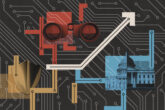February 21, 2022
The Cyber Social Contract
In the spring of 2021, a Russia-based cybercrime group launched a ransomware attack against the largest fuel pipeline in the United States. According to the cybersecurity firm Mandiant, the subsequent shutdown and gas shortage across the East Coast likely originated from a single compromised password. That an individual misstep might disrupt critical services for millions illustrates just how vulnerable the United States’ digital ecosystem is in the twenty-first century.
Although most participants in the cyber-ecosystem are aware of these growing risks, the responsibility for mitigating systemic hazards is poorly distributed. Cyber-professionals and policymakers are too often motivated more by a fear of risk than by an aspiration to realize cyberspace’s full potential. Exacerbating this dynamic is a decades-old tendency among the large and sophisticated actors who design, construct, and operate digital systems to devolve the cost and difficulty of risk mitigation onto users who often lack the resources and expertise to address them.
Cyberthreats represent a betrayal of what advocates promised at the dawn of the digital revolution.
Too often, this state of affairs produces digital ecosystems where private information is easily accessible, predatory technology is inexpensive, and momentary lapses in vigilance can snowball into a continent-wide catastrophe. Although individually oriented tools like multifactor authentication and password managers are critical to solving elements of this problem, they are inadequate on their own. A durable solution must involve moving away from the tendency to charge isolated individuals, small businesses, and local governments with shouldering absurd levels of risk. Those more capable of carrying the load—such as governments and large firms—must take on some of the burden, and collective, collaborative defense needs to replace atomized and divided efforts. Until then, the problem will always look like someone else’s to solve.
Read the full article from Foreign Affairs.
More from CNAS
-
Transatlantic Security / Technology & National Security
Look Before We Leap on Artificial IntelligenceThis article was originally published on The Dispatch. A debate about the role that artificial intelligence should and will play in society, and how it will affect humanity fo...
By Jon B. Wolfsthal
-
Technology & National Security
Caleb Withers on the Cybersecurity Frontier in the Age of AICaleb Withers, research associate at the Center for a New American Security, joins Kevin Frazier, the AI Innovation and Law Fellow at the University of Texas School of Law and...
By Caleb Withers
-
Technology & National Security
Prepared, Not ParalyzedExecutive Summary The Trump administration has embraced a pro-innovation approach to artificial intelligence (AI) policy. Its AI Action Plan, released July 2025, underscores t...
By Janet Egan, Spencer Michaels & Caleb Withers
-
Indo-Pacific Security / Technology & National Security
Sharper: Tech + ChinaRecent talks between President Donald Trump and Chinese Communist Party General Secretary Xi Jinping placed a spotlight on emerging technologies, from high-end chips to minera...
By Charles Horn & Sevi Silvia




